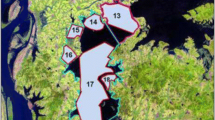Abstract
The present work aimed at studying the rotifer communities of three shallow eutrophic lakes in Portugal (lakes Mira, Vela and Linhos). At the time of the study, Mira and Vela faced large inputs of allochthonous nutrients, while Linhos was facing terrestrialisation, with cycles of dominance-senescence of macrophytes. The three lakes differed in terms of their abiotic features, with Linhos presenting very high nutrient levels and low pH, while Vela and Mira shared most of the characteristics. The rotifer communities of these two lakes were poorly diversified but highly abundant (max. > 2000 ind l−1), with a clear dominance of eurytopic euplanktonic species (mainly Keratella cochlearis). On the other hand, Linhos presented lower abundances (<1000 ind l−1) but higher species richness, mainly due to macrophyte-associated taxa, such as the littoral genera Lepadella, Testudinella and Squatinella. In all lakes, summertime represented a peak in terms of abundance and diversity. Canonical correspondence analysis (CCA) identified two main environmental gradients that shape up the rotifer assemblages: a temporal gradient, mainly related to temperature, and a eutrophy gradient, associated with nitrogenous nutrients. The latter gradient is clearly dependent on between-lake variation, due to the high nutrient levels observed in lake Linhos. Variance partitioning using CCA revealed that the largest portion (27.5%) of the total variation explained (52.1%) was attributed to the interaction between lake and environmental variables.
Similar content being viewed by others
References
T.E. Andrew A.G. Fitzsimons (1992) ArticleTitleSeasonality, population dynamics and production of planktonic rotifers in Lough Neagh, Northern Ireland Hydrobiologia 246 147–164 Occurrence Handle10.1007/BF00014702
Barros P. (1994). Implicações ecotoxicológicas de cianobactérias em cladóceros. M.Sc. thesis, University of Coimbra, Portugal
J.R. Beaver K.E. Havens (1996) ArticleTitleSeasonal and spatial variation in zooplankton community structure and their relation to possible controlling variables in Lake Okeechobee Freshwater Biology 36 45–56
D. Borcard P. Legendre P. Drapeau (1992) ArticleTitlePartialling out the spatial component of ecological variation Ecology 73 1045–1055
K. Christofferson B. Riemann A. Klysner M. Søndergaard (1993) ArticleTitlePotential role of fish predation and natural populations of zooplankton in structuring a plankton community in eutrophic lake water Limnology and Oceanography 38 561–573
J.M. Conde-Porcuna (2000) ArticleTitleRelative importance of competition with Daphnia (Cladocera) and nutrient limitation on Anuraeopsis (Rotifera) population dynamics in a laboratory study Freshwater Biology 44 423–430 Occurrence Handle10.1046/j.1365-2427.2000.00582.x
J.M. Conde-Porcuna E. Ramos-Rodríguez C. Pérez-Martínez (2002) ArticleTitleCorrelations between nutrient concentrations and zooplankton populations in a mesotrophic reservoir Freshwater Biology 47 1463–1473 Occurrence Handle1:CAS:528:DC%2BD38XmvFSnsrs%3D
M. Devetter J. Sed’a (2003) ArticleTitleRotifer fecundity in relation to components of microbial food web in a eutrophic reservoir Hydrobiologia 504 167–175
M.C. Dieguez J.J. Gilbert (2002) ArticleTitleSuppression of the rotifer Polyarthra remataby the omnivorous copepod Tropocyclops extensus: predation or competition? Journal of Plankton Research 24 359–369
Fernandes M.J. (1999). Modelação e simulação nas lagoas de Quiaios. Ph.D. thesis, University of Algarve, Portugal
G. Fussmann (1996) ArticleTitleThe importance of crustacean zooplankton in structuring rotifer and phytoplankton communities: an enclosure study Journal of Plankton Research 18 1897–1915
J. Green (2003) ArticleTitleAssociations of planktonic and periphytic rotifers in a tropical swamp, the Okavango Delta, Southern Africa Hydrobiologia 490 197–209
T. Hanazato (2001) ArticleTitlePesticide effects on freshwater zooplankton: an ecological perspective Environmental Pollution 112 1–10 Occurrence Handle1:CAS:528:DC%2BD3MXktVGqtg%3D%3D Occurrence Handle11202648
J.D. Jack J.J. Gilbert (1994) ArticleTitleEffects of Daphnia on microzooplankton communities? Journal of Plankton Research 16 1499–1512
E. Jeppesen J.P. Jensen M. Søndergaard T.L. Lauridsen (1999) ArticleTitleTrophic dynamics in turbid and clearwater lakes with special emphasis on the role of zooplankton for water clarity Hydrobiologia 408 IssueID409 217–231
F. Koroleff (1970) ArticleTitleDirect determination of ammonia in natural waters as Indophenol blue Information on techniques and methods for seawater analysis Cons. Int. Explor. Mer Servgice Hydrographique – Interlaboratory Report. 3 19–22
N. Kuczynska-Kippen (2000) ArticleTitleSeasonal changes of the rotifer community in the littoral of a polymictic lake Verh. Internat. Verein. Limnol. 27 2964–2967
H.J. MacIsaac J.J. Gilbert (1991) ArticleTitleDiscrimination between exploitative and interference competition between Cladocera and Keratella cochlearis Ecology 72 924–937
R.H. Økland O. Eilersten (1994) ArticleTitleCanonical correspondence analysis with variation partitioning: some comments and an application Journal of Vegetation Science 5 117–126
Pereira R. (1997). Plano de ordenamento e gestão das lagoas das Braças e da Vela (Centro-Litoral). M.Sc. thesis, University of Coimbra, Portugal
R. Pereira A.M.V.M. Soares R. Ribeiro F. Gonçalves (2002) ArticleTitleAssessing the trophic state of Linhos lake: a first step towards ecological rehabilitation Journal of Environmental Management 64 285–297 Occurrence Handle1:STN:280:DC%2BD383pvF2ksA%3D%3D Occurrence Handle12040961
Pontin R.M. (1978). A key to British freshwater planktonic Rotifera. Scientific Publication no 38. Freshwater Biological Association, Ambleside, UK
A. Rüttner-Kolisko (1974) Plankton rotifers Biology and taxonomy. Suppl. Die Binnengewässer Schweizerbart’sch Verlagsbuchlandlung Stüttgart, Germany
M. Scheffer (1998) Ecology of Shallow Lakes Chapman and Hall London, UK
M. Scheffer (1999) ArticleTitleThe effect of aquatic vegetation on turbidity: how important are the filter feeders? Hydrobiologia 408 IssueID409 307–316
M. Scheffer E. Jeppesen (1998) Alternative stable states E. Jeppesen M. Søndergaard K. Christofferson (Eds) The Structuring Role of Submerged Macrophytes in Lakes – Ecological Studies Series 131. Springer New York 397–406
J.D.H. Strickland T.R. Parsons (1972) A practical handbook of seawater analysis Bulletin 167. Fisheries Research Board of Canada Ottawa, Canada
C.J.F. ter Braak (1986) ArticleTitleCanonical correspondence analysis: a new eigenvector technique for multivariate direct gradient analysis Ecology 67 1167–1179
C.J.F. ter Braak P.F.M. Verdonschot (1995) ArticleTitleCanonical correspondence analysis and related multivariate methods in aquatic ecology Aquatic Sciences 57 255–289 Occurrence Handle10.1007/BF00877430
A. Thouvenot D. Debroas M. Richardot L.B. Jugnia J. Dévaux (2000) ArticleTitleA study of changes between years in the structure of plankton community in a newly-flooded reservoir Archiv für Hydrobiologie 149 131–152
V.M. Vasconcelos T. Campos A. Amorim A.M.V.M. Soares (1993) ArticleTitleToxicidade de estirpes de cianobactérias isoladas a partir das lagoas das Braças, Vela e Mira Boletim UCA 1 193–201
Author information
Authors and Affiliations
Corresponding author
Rights and permissions
About this article
Cite this article
Castro, B.B., Antunes, S.C., Pereira, R. et al. Rotifer community structure in three shallow lakes: seasonal fluctuations and explanatory factors. Hydrobiologia 543, 221–232 (2005). https://doi.org/10.1007/s10750-004-7453-8
Received:
Revised:
Accepted:
Issue Date:
DOI: https://doi.org/10.1007/s10750-004-7453-8



